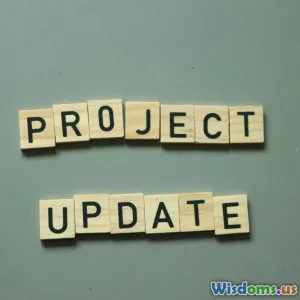
Version Control Confessions What Really Happens on Release Day
8 min read Unveil the truths behind release day chaos through version control, from unexpected mishaps to best practices ensuring smooth software launches. (0 Reviews)
Version Control Confessions: What Really Happens on Release Day
If you think release day is a calm, well-oiled machine, think again. Behind the polished websites and updated apps we enjoy lies a world rife with tension, adrenaline, and sometimes chaos. Version control — the backbone of modern software development — is both a lifesaver and a source of last-minute panic during those crucial final hours.
In this article, we’ll peel back the curtain on release day through the lens of version control. Through real-world examples, expert insights, and candid confessions, you’ll discover what developers experience, the common pitfalls, and best practices for mastering the art of releasing software.
Introduction: The Myth Versus the Reality
Across tech blogs and conferences, release day is often portrayed as a triumph of teamwork and meticulous planning. However, many developers describe it less as a ceremony and more as a battlefield where merge conflicts clash, tests unexpectedly fail, and code changes are scrambled to keep up with changing requirements.
Why does this disparity exist?
- The myth: Continuous integration and deployment pipelines automate many steps, reducing human errors.
- The reality: Every project has its quirks, dependent code branches, and unpredictable last-minute bugs.
Version control systems like Git play a significant role in shaping this dynamic, serving as both the gatekeeper and chaos enabler. Let’s dive deeper.
The Anatomy of a Release Day in Version Control
The Calm Before The Storm: Final Merges and Freeze
Typically, release day starts with a "code freeze"—developers must stop integrating major new features and focus on stabilizing what's in the pipeline. This “freeze” isn’t always absolute; urgent fixes and tiny tweaks inevitably sneak in.
Example: At Spotify, Herman Wagter, a software engineer, revealed that their team calls code freeze a “time to focus,” but urgent bug fixes still mean several hotfix branches get merged close to release. Dependence on feature toggles means changes are sometimes hidden until deployment.
Merge Conflicts: The Unexpected Thorns
When multiple developers modify overlapping code, version control cannot automatically merge, leading to conflicts. During release, this can escalate tensions, especially when the clock is ticking.
Real-world insight: According to a Stack Overflow developer survey, 28% of developers encounter merge conflicts at least weekly. On release day, the frequency spikes as branches converge.
Last-Minute Fixes: Tweaking on the Fly
Despite thorough testing, some bugs appear only in production-like environments. Quick patches via urgent commits pertain to version control challenges like correctly branching from stable tags and ensuring fixes don’t destabilize other components.
Data point: In a survey by GitLab, 62% of teams admitted rushing hotfixes in the final hours, risking technical debt.
Common Version Control Confessions
The "Phantom" Commit Nobody Owns
One classic confession is pushing mysterious code during release without documented authorship or rationale — often done to fix last-minute issues identified on the production server.
The Merge Commit That Broke Everything
Many recall battling with large, unwieldy merge commits created only on release day, merging long diverged branches. This can introduce subtle bugs slipping through review processes.
Rollbacks and the Panic Button
Rollback is the safety net if deployment introduces critical bugs. But an uncoordinated rollback can cause even more confusion, especially if version control branches aren’t updated accordingly.
Quote: As software engineer Beth Skipper puts it, "On some release days, the git revert command gets more action than any other."
Communication Breakdowns Amplified by Code
Version control doesn’t just track code; it’s a communication artifact. Poor commit messages, mismatched branch names, or missing pull request descriptions can amplify stress during release coordination.
Best Practices to Mitigate Release Day Headaches
1. Comprehensive Branching Strategy
Adopt workflows like GitFlow, GitHub Flow, or trunk-based development matched to your project’s size and team.
Example: Companies like Google favor trunk-based development with feature flags to allow continuous releases with minimal branch complexity.
2. Automated Testing and Continuous Integration (CI)
Automated pipelines connected with version control catch integration issues early. A robust CI setup can prevent code that breaks other modules from being committed.
3. Thorough Code Reviews with Clear Guidelines
Reviews enforced before merging ensure changes are understood, improving commit message clarity and preventing buggy commits.
4. Documentation of Hotfix Protocols
Having an established, communicated procedure for emergency fixes reduces ambiguous commits and helps keep the history clean.
5. Use Feature Flags to Decouple Deployment from Release
Feature toggles enable merging incomplete features safely, reducing last-minute changes on release day.
6. Practice Release Simulations
Dry runs or staging environment deployments expose potential pain points without risking production integrity.
Lessons Learned From Industry Leaders
- Netflix: Invests heavily in automation and chaos engineering, testing failure scenarios pre-release to build resilience.
- Facebook: Uses internal tools to enforce code quality with mandatory peer reviews and automated checks, reducing friction on release.
Direct Quote from Former Facebook Engineer (anonymous):
"Our releases are less 'release day' and more an ongoing stream. Version control and CI make sure each change is polished, so when we switch a feature on, the customer only sees stability."
Conclusion: Embrace the Reality, Improve the Process
Release day will likely never be free from tension or complex coordination, but understanding the real challenges around version control and software deployment brings clarity and preparedness.
The stories shared by developers across the ecosystem reveal common themes: merge conflicts, last-minute hotfixes, and communication challenges. These experiences highlight the importance of structured workflows, strong automation, and clear team protocols.
Most importantly, release day is a team effort—a reminder that people and processes matter just as much as the tools.
By adopting best practices and learning from the hardest release day confessions, development teams can turn version control from a source of anxiety into an enabler of smooth, successful software launches.
Rate the Post
User Reviews
Other posts in Software Development
Popular Posts
















